Welcome to Card Game DB
Register now to gain access to all of our features. Once registered and logged in, you will be able to create topics, post replies to existing threads, give reputation to your fellow members, get your own private messenger, post status updates, manage your profile and so much more. If you already have an account, login here - otherwise create an account for free today!
Register now to gain access to all of our features. Once registered and logged in, you will be able to create topics, post replies to existing threads, give reputation to your fellow members, get your own private messenger, post status updates, manage your profile and so much more. If you already have an account, login here - otherwise create an account for free today!
SWLCG Core Box Review - Jedi
Sep 04 2016 12:00 AM |
Majestaat
in Star Wars
Star Wars LCG Community Review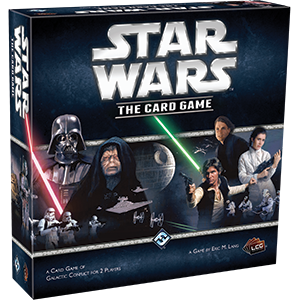 Introducing the new Reviewers:
Introducing the new Reviewers:CobraBubbles:
I’ve been playing on and off since around the start of cycle 2. Unfortunately there are very few players in my area so I don’t get too many games in these days, but I’m an LCG nut and like the mechanics of SW a lot so I do spend plenty of time thinking and theorycrafting about the game. When I do get to play I like to experiment with pods and decks that aren’t considered tier 1 - if you’ve ever heard of me, it’s probably because I gained some notoriety by taking a Sith deck with Virago in it to the top 8 of UK nationals last year..
In writing my reviews I’ll be judging the design of the pods as well as their competitiveness, trying to highlight what was good about the design of good pods, and how bad pods might have been better design. I’ll also be looking at how these old sets are/might be used in modern decks and what new pieces could be released to make them more viable. And finally, as a regular AGoT and Netrunner player, I’m hoping I can bring some insight by comparing this game to the other LCGs. Looking forward to it!
BakaMatt:
I'm a passionate casual of the game who has played since the start, although I've been constrained to a very small playgroup and haven't once taken part in any tournament level. I originally got my ears wet with a little-known game called Magic: The Gathering in the 90s and have been a card game fan ever since, naturally gravitating to Decipher's Star Wars CCG when it arrived on the scene and dabbling into other games along the way, like the old VS System, the Lord of the Rings LCG and 1st edition Game of Thrones. I describe myself as a "passionate casual" because despite my limited direct involvement in the competitive scene, I am still very much on top of the latest news - what's making rounds in regionals/nationals/worlds, what's being said amongst numerous podcasts and what is up-and-coming in the future. I'd like to think what experience I have is made up with heart.
THE RATING SYSTEM:
We'll only be rating the pods as a whole in these series. No in-depth analysis on the individual cards, as everyone already has an established opinion on them and it would take more time than what we can afford. Sorry to disappoint.
While the following isn't particularly precise, the different scores could be seen as:
1 - Poor - Probably a combination of subpar cards, low edge and lack of synergy. Should prove to be a weak addition to a deck even when building around it.
2 - Bad - Overall a weaker pod that can have its moment when properly supported, but usually stays within the realm of "just fun".
3 - Average - A fair choice that is simply outclassed by other options in most cases. May prove to be the superior pick in very particular decks.
4 - Good - All-around solid and can most likely pull its weight by itself.
5 - Great - Cohesive set with with several strong elements which can fit in a plethora of decks. Or it may be somewhat niche but incredibly strong in certain archertypes.
THE REVIEWS:
A Hero's Journey: 13 out of 15 possible points.
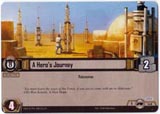
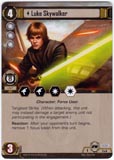
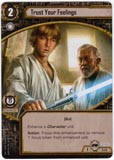
CobraBubbles (4/5) - The classic main pod on the light side. Straight out of the gates, Luke set the standard for what to expect from four 4 light side units: at least 3 pips, 3 health, 4 combat icons, a keyword and a versatile ability. The Twi’lek, likewise, sets a good bar for what 1 cost vanilla units should be, able to have some impact in combat, but pretty easy for the dark side to deal with. The enhancements are in that design sweet spot where they synergise wonderfully with the main in their pod, but also with almost any other eligible target you care to name. And the set provides plenty of resource ramping, which is necessary for the Jedi mains style, as you want to be putting out a main and a support card (chud, enhancement, event) every turn if you can.
In short, this pod pretty much defines a main way of playing the game all by itself, while remaining balanced due to the lack of text and 4 health on the objective, and the risk that the Twi’lek will die before doing anything. Great design, and it has remained a great pod in play as well. Only loses a point from me because there’s not really any fun internal synergy.
BakaMatt (4/5) - Four years into the game's life this objective set is still seeing a lot of play, and it's not hard to see why. Everything is a playable card that doesn't feel bad drawing into. Luke is a powerful main that does double duty on both your and your opponent's turns with a very satisfying icon mix for the light side. Twi'lek Loyalist is probably my favorite non-main ever, with the ability to throw a wrench into enemy plans at the low cost of one resource. Jedi Lightsaber is similarly cost effective for the icons it brings to the table, pitching for 2 icons in edge should the need arise. Trust Your Feelings is an admittedly higher investment, but being able to effectively double-up on your strongest character is nothing to snuff at. Round things off with a cheap resource enhancement and you have the gold standard of Core set design with every card serving a positive role without feeling over or under the curve of power. What keeps Journey from landing a perfect score is the objective itself that, while providing a resource boost, is fragile and a slight bonus to any aggressive dark side matchups.
Majestaat (5/5) - This is usually a great starter set for Jedi decks. Core Luke is very straightforward and strong without requiring support. He hits hard against both units and objectives, while providing some control via targeted strike and a solid defense with his reaction.
The Twi'lek is super cheap tactics. A great way to force bad decisions on your opponent.
Then we get an efficient resource and a couple enhancements that are great fits on most Jedi mains.
If I had to name some drawbacks, those would be the objective (by today standards, there's little to no reason for it to have 4 damage capacity) and lowerish edge. But ultimately, those aren't enough to bring this pod down. There's a reason it still sees extensive play, and I'd dare say it's the most flexible Luke pod out there.
In You Must Go: 10.5 out of 15 possible points.
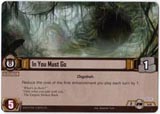
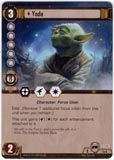
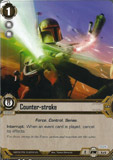
CobraBubbles (3/5) - First thing to note, the objective gets flavour points for being the first card in the game to feature a quote from the film, allowing players across the world to giggle at each other’s poor Yoda impressions. That’s important design space and I’m glad it got covered straightaway in the core set.
This set is also a good opportunity to remind ourselves of FFG’s biggest teething problem with developing the pod system: a lack of focus on internal synergy. The internal synergy of a pod is usually both the most interesting thing about it and what gives it potential to be impactful in competitive play. In this case, IYMG and Yoda have clear synergy with enhancements, so Counter-stroke feels out of place here. The cancel effect to protect your voltron makes sense, but if this set was designed now I’m sure there would be a third enhancement in that slot, something else to stack Yoda with. Also Yoda would have 3 health, because what’s the use building an enhancement tower that dies so easily to Vader, or even a lowly Stormtrooper? Also worth noting that Shii-Cho Training started the unfortunate trend of giving Jedi enhancements extremely conditional effects.
Core Yoda was a mainstay of Jedi decks at least up until they released his counterpart in May The Force Be With You. These days he fits into the ever-growing category of decent Jedi 1-ofs. He brings a couple of things that are tough to find elsewhere on the light side: a 5-pipper to boss the edge and force struggle with, a very powerful economy-ramping effect, and surprise event cancel. Worth a look back at him if you get sick of all the good Sith & Scum events they keep printing/reprinting (I’m looking at you, Captured).
BakaMatt (3.5/5) - Believer in the Old Ways and Shii-Cho Training may almost always be fodder, but the rest of the set compensates. The objective's effect is always on, netting free resources in just about any deck that flops it. Resource enhancements are a core consideration of almost every deck build and In You Must Go not only discounts them, but also provides one in the form of Dagobah Training Grounds. While outclassed by every Yoda released since Core because of his fragile damage capacity of two, Core Yoda is still an amazing card for either holding the force or clinching an edge battle. A number of decks even build around Yoda as an affectionately named "Christmas tree", turning him into a one-man wrecking ball. The last card worth mentioning in the set is Counter-stroke, a powerful tool for cancelling events. Counter-stroke is harder to keep around than the more "sticky" counters (Core C-3PO, Trust Me, Ferus Olin) because game mechanics favor a constant cycling of cards rather than holding onto them, but the edge benefit that Counter-stroke brings is that it is hidden and can be a surprise play for your opponent to have to consider and play around or else get caught offguard. Overall, In You Must Go has a mix of very powerful cards sprinkled with a touch of less than stellar offerings. It makes for what seems like an uneven pick at first glance, but wouldn't be unusual to see in today's builds.
Majestaat (4/5) - I'm always surprised how underrated this Yoda is. Certainly, he's not an imbalanced piece of Bantha fodder like his Echoes and BtS counterparts, but his stats are still quite amazing. Even though he's not a fighty unit without enhancements, his job should be supposed to defend and hold the Force. 5 icons and elite for only 3 resources is very hard to match, especially now that Sith Choke spam isn't as popular as it used to be (though to be fair, that was about the only "good" DS deck played during core days).
The objective is one of the best resource ramps out there, making your enhancements incredibly cheap. Free Dagobah Training Grounds? Won't say no to that. Combined with Hero's Trial it can be a real headache for the DS.
We also get a very valuable event cancel here. So far, this is a perfect set with some great individual cards, resource and 10 pips. The Believer and Shii-Cho are what bring it down. The former is too uninspiring. The latter, almost useless without big setup.
Forgotten Heroes: 9 out of 15 possible points.
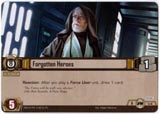
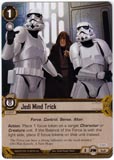
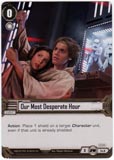
CobraBubbles (3/5) - Once again, the thing that sticks out about this pod is a missed opportunity for internal synergy. Our Most Desperate Hour is a good card, but what on earth is it doing here? None of the other cards in this pod provide anyway of gaining or capitalising on shields. The pod would be much better with another Force User chud in that slot to maximise the utility of the objective.
There are a few other almost-theres here in terms of internal synergy. The Heat and the chud could work well together on defense, except that the chud is so easy to kill. The objective and Obi-Wan work together to give you edge advantage, but then the Mind Trick makes edge battles less important. That said, it is good for the cards in a set to be individually versatile as well as synergistic, so it’s nice that Mind Trick can help you out when you don’t see your edge-advantage cards.
This set is an exciting example of how new cards can bring *ahem* Forgotten pods back into the spotlight. The back-to-back releases of T’ra Saa’s set and the Mystics brought the number of cheap Force Users in the game to the critical mass needed to make Forgotten Heroes the centrepiece of a new kind of Jedi deck. That deck is still not great, hence my average rating, but it sure is fun. The precedent this example sets is an important one to bear in mind when considering how some of these older sets could be made better.
BakaMatt (3/5) - Obi-Wan Kenobi is a costly main who is quite versatile. He can hold the force well, Elite is one of the best keywords in the game, he has solid survivability, and he grants a useful boon to the edge battle. His icon spread can lack punch when it comes to destroying objectives, but he makes an excellent tool to clear the way with double tactics and a body to threaten a repeat peformance turn after turn. Our Most Desperate Hour is a free shield at event speed, allowing doubling up shields on an already shielded unit. Not even counting the best scenarioes where a deck is built to capitalize on shielding, this event can often be that thorn in the side of an opponent who was counting on eliminating a unit before the engagement started and didn't bank on needing to deal one more damage. Heat of Battle is a good solid edge card that doesn't need too many words to express how useful free damage can be. Jedi Mind Trick is versatile. My favorite use is to lock down a unit in an engagement after seeing how the edge pans out, but it also can sneakily steal the force for a turn. The problem is that it doesn't help a lick against vehicles and when facing down such a build, it isn't much of an edge contribution either. Forgotten Heroes has the same specialized issue. In a deck with heavy concentration of Force Users, it shines as free card draw. To get a lot out of it, you need to run sets with lots of cheap units such as The Forgotten Masters or Mysteries of the Rim - not bad choices in their own right, but both are heavily tilted to serving support roles in a deck, neither include a resource, and Forgotten Heroes is also both support and resourceless. On the other hand, a deck featuring a lot of "main" Jedi, the objective will only grant an occassional draw, better than some objectives, but also worse than many. Lastly, we come down to the card that about single-handedly pulls the set down from 4 to 3, the Jedi in Hiding. It's a Force User, so it can sort of cycle with the objective into a new card. In most cases, though, the best use of it is to pitch it during your draw phase. Expensive and fragile, you are rarely going to come ahead when playing it.
Majestaat (3/5) - Geh, seems like we keep decaying. Much of the set power's budget is in the objective, which only makes an important difference in a force user swarm deck (usually one with The Forgotten Masters), in which it is a terrific draw engine. In other decks you're drawing a card per turn at most. Not like that's bad, but the rest of the set doesn't make up for it.
As much as I like Obi, his combat array is too weak for his cost, and there's not even a resource here to make him playable. Not cool.
The Jedi in Training is fair. Sacrifices HP for a bit more firepower. Though black guns aren't exactly what LS needs the most. If he had 2 pips, he could have made a decent force holder/defender, but that's obviously not the case.
The events and Heat are all very playable and useful. No complaints there, though it could be argued that swapping Our Most Desperate Hour with the Lighsaber Deflection from Secrets of Yavin 4 would have made a lot more sense.
If we ever get another set with several cheap force users, and maybe a resource, Forgotten Heroes could see a massive boost.
A Journey to Dagobah: 11.5 out of 15 possible points.
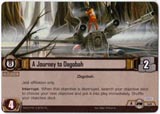
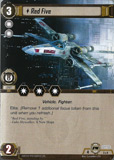
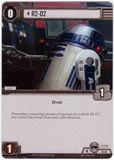
CobraBubbles (4/5) - So far we’ve had 3 different kinds of Jedi main set: an archetypal main set, a high-risk high-reward voltron set, and a versatile/confused set that inadvertently laid the foundations for a new decktype. Pod number 4 is yet another type, managing to be both a main set and a support set at the same time. Red Five is the best 3 cost unit in the core set, and the Target works with it to facilitate one-shotting objectives - the business of great mains. But Double Strike and the objective are clearly intended to make cards from other pods better.
Given my previous complaints about internal synergy you’re probably expecting me to dislike this set. In fact I’m a fan. This is one of very few sets in the game that effectively straddles the support/main divide. The main is good enough on its own that the lack of synergy with other Jedi cards doesn’t matter too much, the support cards make other mains and their objectives better, and it comes with plenty of resource ramping to let you play Red Five with another powerful main for some big turns. This set would still be a very good one-of in modern Jedi decks even if Unfinished Business didn’t exist, but it’s because that combo is a thing that I’m rating high here.
BakaMatt (3.5/5) - Red Five is a little fragile, but three black blast is a lot of punch. If you can surprise drop this, or better yet, squeeze it through by clearing the way with tactics, you can drop all but the hardiest of objectives almost singlehandedly - even just pairing it with Target of Opportunity can bring four damage, or snap an entire objective if unopposed. R2-D2 is a good, if boring, resource accelerator. Double Strike is the one awkward inclusion, working with character units in a vehicle set. If Journey to Dagobah is included in a character-heavy deck it provides a mini-Trust Your Feelings that isn't telegraphed. Otherwise, it's weak edge fodder.
Majestaat (4/5) - Here's something good, with low edge being its only glaring weakness, especially with how fragile its units are.
Red Five doesn't get enough credit. It really brings the pain against the DS. With 3 black blast, it only needs to strike once to pay for itself. Makes up for Jedi's rather low blast, and together with the Moldy Crow and Luke's Landspeeder, can provide a decent amount of powerful attackers that are immune to Sith's best tricks.
R-2 and the Twi'lek are very efficient at what they do. The resource ramp from the little droid can be especially valuable against the Tarkin tax. Combined with the 2 resources on the objective, you can have very strong openings.
Double Strike and Target of Opportunity are yet more cheap tools to deal extra damage, yay!
If Navy and/or focus control Sith are dominant in your meta, I'd urge you to play this pod.
The Secret of Yavin 4: 12.5 out of 15 possible points.
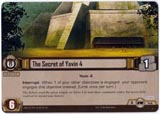
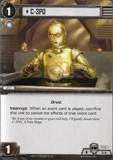
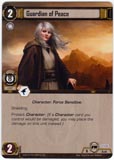
CobraBubbles (4/5) - Now we get on to a proper support set. This set defines the mainless pod type just as Luke does the main type. It has a good coherent theme: providing soft counters to dark side effects that will disrupt your gameplan. I say soft because none of the cards here are gonna both protect you and wreck the dark side’s day in the way that, say, Qu Rahn does (Deflection can be pretty brutal, but more often it’s used purely defensively).
All the cards in the pod are pretty much right on the curve, so I won’t say much more about them. There are some missed opportunities for cross-set synergy here that are worth noting though. It would have been really nice for the Guardians to be Force Users so they trigger Obi-Wan’s objective - since they’re not, the Force User swarm deck that could have been a thing straight out of core had to wait several cycles for the pieces it needed, leaving Jedi with only one real strategy at the start of the game. Also, it would have been nice if the objective let you redirect the attack to any one of your objectives, so that you’d actually have a way to get Red Five’s objective triggered. But enough complaining. These are 6 cards that all make your best Jedi cards better, and the pod has 3 units which helps a bit with those ‘Jedi draws’ we’ve all grown to dread. This was the glue that held Jedi decks together for a long time, so anything less than a 4 seems unfair.
BakaMatt (4/5) - Before Qu Rahn released, this was *the* set for light side to turn to for character protection, unless running Wookiee Life Debt (and even with Debt, the protectors here aren't reliant on flopping the objective). Secret provides everything you need for a protective shell in the form of objective protection via Secret of Yavin 4, event protection from C-3PO, character protection with two shielded protect units, and a Twist of Fate for good measure. What it does lack is raw edge and a resource. This set remains a viable and potent tool for the jedi arsenal, sometimes even in addition to its popular replacement of The Survivors. If you can recur Threepio reliably with something like Obi-Wan Kenobi (BotF) or Hyperspace Marauder, it gets even better.
Majestaat (4.5/5) - Very specialized pod. This one is all about defense at a cheap price. It does have abyssmal edge, but Jedi can afford to pick one set like that. In exchange, they get protect for their objectives, for their characters and even shielding to counter tactics. Also event cancel, though it's telegraphed; and the very amazing Lightsaber Deflection, that doubles as a protection and direct damage tool.
To close the set is the great Twist of Fate, to keep your opponent honest when approaching edge battles.
Sadly, this set lost much of its niche with the release of The Survivors, at least in the traditional Jedi mains decks. It's still a very useful pick for Rebel or Smuggler characters, and thanks to Spark of Rebellion, it's found place in character swarm decks.
Last Minute Rescue: 7 out of 15 possible points.
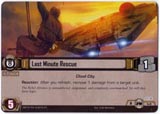
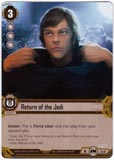
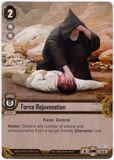
CobraBubbles (2/5) - If you’re afraid of those unit-less Jedi draws, here’s one pod you should avoid running. 3 events and a unit with no combat icons is a recipe for a bad pod. It’s interesting to compare this to the newest Luke set, which is similarly unit-light and defensively-minded.
Search Your Feelings and Redeem The Fallen (comparable to events as it’s also a one-shot effect) offer some of the most powerful effects the light side has access to, each at only one cost. Return Of The Jedi and Force Rejuvenation are comparably powerful, though more expensive, but with more pips to compensate for that. Each pod also has an event which is much more conditional, but Emergency Repair is a fair bit worse than I Will Not Fight You given that it costs two and doesn’t really help you win the game in the way that IWNFY occasionally can. What really differentiates these pods though is their mains. Luke, like his other versions, can take on the best units on the dark side by himself, and presents a real threat to the opposition’s gameplan. Redemption, unfortunately, is not really a main at all. For 5 cost you get core Luke’s stats with 1 more health but worse icons, and no Elite to make it a good force holder. And the ability doesn’t really impact the board at all, being much more of a support effect.
People are experimenting with A Hero’s Duty because it makes up for its unit-light composition with a great main and some very powerful effects on the non-unit cards. I doubt anyone was ever as excited about Last Minute Rescue. When you look at a set and think ‘I’d really like to use those events, but those units are a pile of Bantha sh*t’, that’s a sign that it’s neither particularly good nor particularly fun. Not giving it a 1 though because it does have ten pips, and Rejuvenation is just that good.
BakaMatt (2.5/5) - You're usually going to want to pitch Corellian Engineer and Emergency Repair, but the rest of the cards are pretty good. Last Minute Rescue isn't proactive as Fleeing the Empire, making it less useful upfront, paying off over time. Redemption is costly with a good statline. The real stars of the show are Return of the Jedi and Force Rejuvenation. Aside from bringing back a defeated Force User, Return enables a line of play where you can pitch a costly unit to win the edge and bring that unit back into play. Most Force Users have good force icons that make them prime edge cards. Best of all, Return of the Jedi is an action and allows all sorts of shenanigans like a surprise engagement after already using your units in play, shifting control or the force, or even just dropping a jedi unit during your opponent's turn. Be careful of telegraphing, though, as it does cost a hefty three resources. Force Rejuvenation is an incredible all-star card of versatility, dropping off damage, enemy enhancements and focus at action speed. Suddenly, your almost dead Luke springs back to life to take another swing, or your tactics buried Han Solo is freed from lockdown to continue his assault. If the engineer had a combat icon and Emergency Repair a higher edge count, I think this set would see more consideration. As it stands, it's usually just more efficient to run the more solid recent sets.
Majestaat (2.5/5) - Incredibly expensive support set without a resource to help solve its issues. The objective is free healing, which can come handy for your mains, especially Qu Rahn or any unit with protect, really.
Redemption iis really lacking for its cost. Sure, getting to recur Jedi mains with their crazy high edge values may be a little too strong, but come on, this costs 5 and has little synergy with what Jedi want to play. It could have used more black icons and/or a keyword, to say the least.
I'd rather not say anything about the Engineer because I don't want to come as the vulgar type.
Force Rejuvenation has always been amazing, while ROTJ and Emergency Repair are much more useful now thanks to more big Force Users (Ferus, T'ra Saa, Ahsoka to name a few) and DS being more aggressive, respectively.
So you get some very nice utility events, and overall strong edge. However, high costs, no resource and no good units makes this set pale in comparison to other utility/defensive pods like The Survivors and Secrets of Yavin 4.
Jedi Training: 5.5 out of 15 possible points.
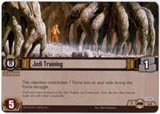
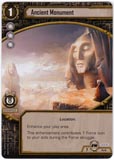
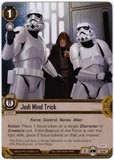
CobraBubbles (1/5) - Oh lordy. Our first ‘what were they thinking’ set (and not the last we’ll see in this series, alas). Basically zero internal synergy… or external synergy for that matter. Yeah, It Binds All Things is an ok support card, but having to pay for it is a kick in the teeth since you don’t get to choose what you get and you’ll have to pay for the recurred card(s) anyway. Even worse is having two cards that scale up when you have balance, in a pod with two 1-pip units. Sure the objective and the Monument help out, but not by much and anyway the Monument is the only good edge card in the pod so you’ll wanna pitch it. There’s 7 total pips here. 7 pips in a set with two weak-ass vanilla units. I don’t think I need to go any further into why this pod is bad - irredeemably bad.
BakaMatt (2.5/5) - It Binds All Things lets you replay your best card, which is something. It's also the card that enables the first infinite combo in the game using two copies to recur itself alongside Leia Organa. Jedi Mind Trick can be pretty good, as I discussed during my review of Forgotten Heroes. The problem is there isn't any incentive to play weak cards and every unit in Jedi Training is weak. These units have low force count and aren't much help at fighting to control the force and their statlines are awful. We just had a whole Endor cycle with many pods designed around encouraging weak unit play. After repeated releases, Ewoks are awful even with their support cards. The random non-main Jedi here are worse off and unless you're looking to set up something with the events combo, this set is an easy pass. To make it playable, the objective and/or Monument should have provided some sort of boost for your non-unique Jedi and either a resource, or higher force icon count among the cards to make something about it desirable. As printed, it is a collection of assorted bits that don't really appeal to any one type of deck.
Majestaat (2/5) - This set proposed an interesting concept with an alternate way to contest the Force in the objective and Monument, while offering some minor rewards for holding it.
Unfortunately, the individual cards aren't good enough. The units and It Bind All Things are all rather mediocre, with Jedi Training and the Monument being just fair. Jedi Mind Trick is very good, but not enough to carry this set. Without a heavy-hitter to make use of the window of opportunity provided by the Mind Trick; lack of decent Force holders to complement the alternate mechanisms offered here (and thus gain the rewards from the other cards); low edge that makes the white blast on the units even worse; and no resources to support the rest of your deck, there's little reason to pick this set.
FINAL WORDS:
And thus begins this new project about old cards. Due to the Core's box extension, we're dividing it among several parts, Jedi being the first as you just saw. Next are Rebels and then Smugglers + Neutrals. Once we're done with the Light Side, we'll proceed to the Hoth Cycle.
Because we already know the cards and the reviews are rather shorter than normal, I expect a new article to be uploaded every 2 weeks.
I extend my gratitude to the new review team and the readers who motivated us to do this. I'm sure there's room for improvement. If you got any ideas, feel free to comment or PM me so we can make the next article even better.
I must say, however, that there's a limit to how many images can be uploaded. That's why I only selected a few images per pod.
If you're looking for more reviews, you can find them in our forum thread here.
May the Force be with you all!
- CobraBubbles, 4wallz, yodaman and 5 others like this



 Sign In
Sign In Create Account
Create Account











1 Comments
thanks for this analysis.
I am playing this game casually,
currently have 2 core sets and deluxes.
having fun.